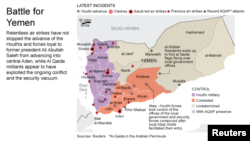Yemen's conflict between Houthi rebels and the internationally recognized government in Sana'a has hurled the country into chaos, but most observers know the situation on ground is much more complicated.
For many, the Yemen conflict is seen as another proxy war between rivals Iran and Saudi Arabia, both vying to maintain or tip the regional balance of power in their favor.
Peter Jenkins, a former British ambassador to the International Atomic Energy Agency, warned that the Houthis are not exactly agents of Iran, which denies supporting the Houthis militarily.
“I think it's wrong to think of the Houthis as proxies for the Iranians," he said. "I think it’s more that there is a mutual sympathy that rests in part on the Shi'ite brand of Islam, but they’re not proxies so they can’t be controlled by Iran."
Saudi Arabia, however, is openly fighting the Houthis with airstrikes, supported by Jordan, the United Arab Emirates, Kuwait, Qatar, Bahrain, Morocco, Egypt, Sudan and the United States.
This show of force intended to cripple the Houthis, said Summer Nasser, an activist based in the country's south, also is crippling civilians.
“Air bombardments by 10 countries are too much for this small, impoverished society," she said. "But if Houthis do [hold a] dialogue, I don’t even think Saudi Arabia will take it seriously because Saudi Arabia wants to destroy Houthis as much as they can before any kind of settlement."
The Houthis have continued to maintain their long-held, firm control of northern strongholds near the Saudi border. Since beginning an offensive last year, however, the rebels have also taken the capital, Sana'a, and many of the towns and cities along the country’s main highway. They have also control the road from Sana'a to the port city of Aden, which is now the heart of the battle zone.
In southern Yemen, where battle lines become even more complicated, ousted president Ali Abdullah Saleh is now allied with the Houthis, despite waging war with the group for six years while in office. As a result, the government army is divided in its loyalties, with some fighting for Saleh and some fighting for President Abd-Rabbu Mansour Hadi.
Neither man is in Yemen as far as anyone knows, and some soldiers are not fighting at all, leaving residents and tribesmen to fend off the Houthis’ allies, who are taking control of places without the permission of the people who live there.
Meanwhile, said U.N. spokesperson Stephane Dujarric, fighting continues to escalate.
"Thirty-seven buildings were targeted, including five hospitals in Sana'a, al-Dali and Aden," said Dujarric. "UNICEF says that yesterday's airstrike on the al-Rashidi school in Yemen's Ibb governorate, which left at least two children dead and two others injured, is a stark reminder of the appalling risks faced by children as the conflict intensifies."
The Houthis are a militia of Zaidi Shias, a sect in power for 1,000 years before the 1960s, when a republican army overran the imamate, and remain a large minority in the mostly-Sunni nation of less than 25 million people.
The United Nations says nearly 600 people have been killed since the airstrikes began, including more than 75 children, and hundreds have fled the country. And as this disaster unfolds, Yemeni people appear increasingly beholden to neither side, calling only for the war to stop.
Fras Shmsan contributed to this report from Sana'a.











